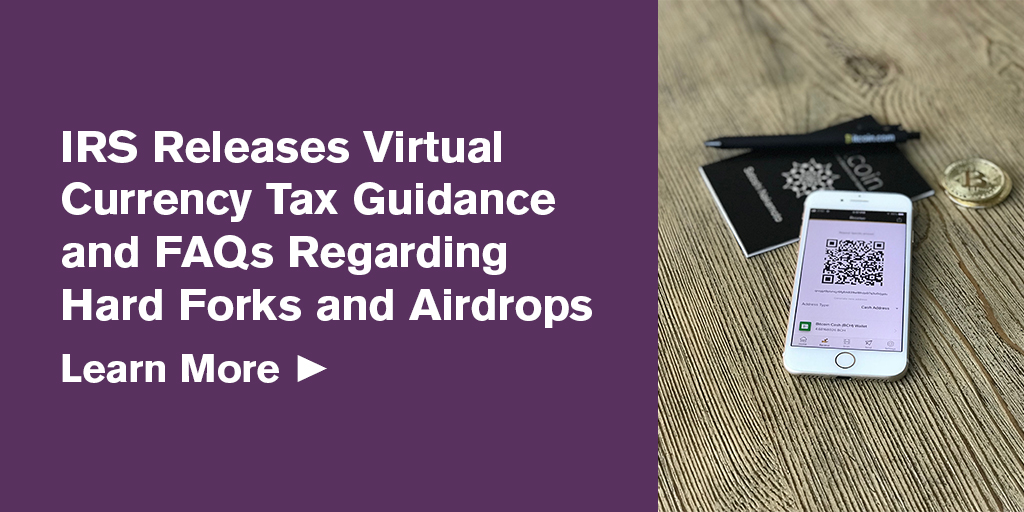The blockchain and digital assets community and tax professionals have been anxiously waiting for additional IRS cryptocurrency guidance, and they finally received it on Thursday.
In addition to finally issuing Rev. Rul. 2019-24, the IRS updated its Frequently Asked Questions on Virtual Currency Transactions webpage by summarizing guidance into 43 Questions and Answers in hopes of clarifying cryptocurrency tax obligations.
Virtual currency stakeholders waited patiently for the additional guidance after IRS Commissioner Charles Rettig replied to April 11, 2019 letter from 21 U.S. Congress members urging the agency for basic reporting requirements. The public, based on the Commissioners May 16, 2019 response, expected the IRS would address controversy around the acceptable method for calculation virtual currency cost basis, the acceptable methods for cost basis assignment, the treatment of forks and to provide additional guidance with respect to many items not addressed in the Notice 2014-21.
The Ruling
The IRS issued the ruling to address two specific virtual currency transactions – hard forks and airdrops.
A hard fork is a change to network's protocol, which can validate or nullify blocks and transactions. When virtual currency, like Bitcoin, undergoes a protocol change, the result is a permanent diversion from the existing distributed ledger. A hard fork generally requires all nodes or users to upgrade to the latest version of the protocol software. The result is a creation of a new cryptocurrency on a new distributed ledger.
An airdrop is the means of distributing crypto coins or tokens to the distributed ledger by awarding them in a certain proportion to existing holders of a particular blockchain currency. There are many different reasons for airdrops, including marketing, forks, decentralization, distribution, etc. Airdrops can be delayed to increase market participation using locking periods.
The recent IRS Ruling lays out two examples to help taxpayers understand reporting obligations – one for hard fork and the other for airdrop. In the first example, Taxpayer A receives allocation of new cryptocurrency units through a hard fork. However, no units are airdropped (transferred) to an account owned or controlled by Taxpayer A. In the second example, after a distributed ledger experiences a hard fork, the resulting cryptocurrency is airdropped to Taxpayer B, who has possession and control of the cryptocurrency immediately after the transfer.
With respect to the first example, the Ruling concludes that because Taxpayer A did not have an “accession to wealth” (e.g. procession, dominion and control), the hard fork did not result in a taxable event. However, in the second example, the airdrop resulted in a taxable event because Taxpayer B had the control to transfer, sell, exchange or dispose of the virtual currency. The Ruling further concludes the income is ordinary income in the taxable year when the cryptocurrency is received based on the fair market value of the units.
Understanding the Impact of the Ruling
The Ruling represents general guidance that can be relied on by taxpayers, IRS personnel and tax professionals. While the Ruling represents the IRS’ conclusion based on a specific set of facts and the analysis of the Internal Revenue Code and related statutes, Treasury Regulations and case law, the Ruling is not a tax law.
Facts and circumstances of each hard fork and airdrop transactions must be carefully reviewed, examined, summarized and documented. Each transaction may have a unique set of facts and circumstances that could result in a different interpretation by federal or state taxing authorities. For instance, the Ruling only addressed a hard fork and did not address a soft fork or other fork types. The Ruling also did not address participation or locking periods for airdrops or situations involving technical glitches or network re-launches, etc.
Then analyzing forks and airdrops, taxpayers should:
- Understand the technology and its impact on a transaction or a series of transactions
- Review substance and form of each transaction by comparing the actual outcomes with intended results
- Analyze other transactions that occurred contemporaneously with or immediately before or after each transaction, including any contingencies
- Understand crypto issuer’s or facilitator’s (exchange, etc.) digital asset account and custody policies
- Understand which party bears the risk of loss throughout each transaction or milestone dates
- Obtain valuation of digital assets and methodology, and timing being used for valuation, if needed or required
- Review stakeholders’ rights and obligations in each transaction
- Review any legal documents, blogs, timelines, flow-charts for each transaction, if applicable
- Gather other necessary information, documents and details of the transaction, no matter how small, which could potentially result in different tax consequences.
Understanding the Q&A
In addition to the Ruling, the IRS significantly expanded the Questions and Answers section of is Virtual Currency Transaction site.
The Ruling and the updated Q&A are important milestones. However, additional guidance will be needed going forward to clarify many controversial issues the Ruling and the Q&A have not yet addressed.
Specifically, the IRS has not addressed non-convertible virtual currency or other digital assets (not all digital assets are virtual currencies). Although the IRS specifically referred to Sections 1011, 1012, and 1016 for purposes of determining the gain or loss from the sale or exchange of virtual currency, there is still no specific clarification regarding the acceptable accounting methods and basis tracking methodology. The Q&A also did not specifically address taxpayer documentation requirements for standing orders or instructions under the basis reporting; and, how it applies to market makers, facilitators, exchanges, etc. Furthermore, there is no additional guidance for wash sales or Section 1031 application for transactions that occurred before January 1, 2018.
Conclusion
BPM’s Blockchain and Digital Assets team is continuing to analyze the new IRS guidance. The IRS made significant progress in reaching out to the taxpayers, governmental agencies and professional organizations. It also significantly increased its enforcement and educational efforts over the last couple of years. Contact BPM’s Dmitri Alexeev, Tax Partner, today for all digital asset and blockhain tax matters or to find how this new guidance may affect you.
BPM for Blockchain/Digital Assets
BPM is one of the largest West Coast-based CPA firms that specializes in serving the digital assets and blockchain industry. BPM provides individual and business tax compliance, consulting and tax structuring services. Our professionals have extensive knowledge and experience in dealing with accounting and auditing matters, as well as regulatory and compliance issues, including revenue recognition, IT compliance, enterprise risk management and classification of digital assets. Click here to learn more.
 The blockchain and digital assets community and tax professionals have been anxiously waiting for additional IRS cryptocurrency guidance, and they finally received it on Thursday.
The blockchain and digital assets community and tax professionals have been anxiously waiting for additional IRS cryptocurrency guidance, and they finally received it on Thursday.

